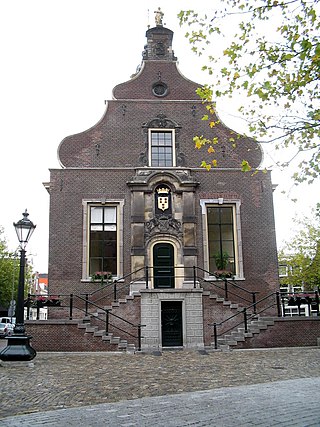
Schiedam is a city and municipality in the west of the Netherlands. It is located in the Rotterdam–The Hague metropolitan area, west of Rotterdam, east of Vlaardingen, and south of Delft. In the south the city is connected with the village of Pernis by the Beneluxtunnel.

Middelburg is a city and municipality in the south-western Netherlands serving as the capital of the province of Zeeland. Situated on the central peninsula of the Zeeland province, Midden-Zeeland, it has a population of about 48,000.

Gouda is a city and municipality in the west of the Netherlands, between Rotterdam and Utrecht, in the province of South Holland. Gouda has a population of 75,000 and is famous for its Gouda cheese, stroopwafels, many grachten, smoking pipes, and its 15th-century city hall. Its array of historic churches and other buildings makes it a very popular day-trip destination.

Veere is a municipality with a population of 22,000 and a town with a population of 1,500 in the southwestern Netherlands, in the region of Walcheren in the province of Zeeland.

Gorinchem, also spelled Gorkum, is a city and municipality in the western Netherlands, in the province of South Holland. The municipality covers an area of 21.93 km2 (8.47 sq mi) of which 3.10 km2 (1.20 sq mi) is water. It had a population of 37,410 in 2021.

Tielt is a Belgian city and municipality in the province of West Flanders. The municipality comprises the town of Tielt proper and the villages of Aarsele, Kanegem, and Schuiferskapelle.
Adriaan is the Dutch and Afrikaans spelling of the given name Adrian. Before the 19th century the spelling Adriaen was also common, and people used the spelling interchangeably.

Dutch architecture has played an important role in the international discourse on architecture in three eras. The first of these was during the 17th century, when the Dutch empire was at the height of its power. The second was in the first half of the 20th century, during development of modernism. The third is not concluded and involves many contemporary Dutch architects who are achieving global prestige.
Events from the year 1657 in art.

The Museum of Fine Arts an art museum in Ghent, Belgium, is situated at the East side of the Citadelpark.
Pieter is a male given name, the Dutch form of Peter. The name has been one of the most common names in the Netherlands for centuries, but since the mid-twentieth century its popularity has dropped steadily, from almost 3000 per year in 1947 to about 100 a year in 2016.

Wijnendale Castle is a historic residence in Wijnendale, West Flanders in Belgium which was once a medieval castle. The present buildings largely date to a nineteenth century restoration, though parts of the north wing still date to the fifteenth century. One wing is currently inhabited by the present owners of the castle, while another is open to the public as a museum.
Ravesteyn, also written as Ravensteyn, Ravenstein or Ravestein, was a 18th-century East Indiaman of the Dutch East India Company.

Cornelis Cels was a Flemish painter of portraits and religious subjects. He was a professor and director of the Académie des Beaux-Arts de Tournai. He was patronized as a portrait painter by the court of The Hague.

Gunterstein Castle is a castle in Breukelen, on the river Vecht, that was the former home of the rich Dutch widow Magdalena Poulle (1626–1699). She bought the property and associated title after the former castle and stronghold was destroyed by the French in the Disaster Year Rampjaar 1672.
Theodoor is a masculine given name. It is the Dutch form of Theodore. Short forms of Theodoor are Theo, Dorus, Dirck, and Dirk. The latter two are derived from the Germanic name Theodoric rather than from the Greek/Latin Theodorus. People with the name include:
Lieven is a Dutch language masculine given name. A Germanic name, it derives from Lief-win, meaning "dear friend". The name was popular in the Low Countries through the Anglo-Saxon missionary Liafwin who died around 775 in Deventer. Veneration of Saint Livinus of Ghent, who was probably invented in the 10th or 11th century and modeled after Lebuinus, made the name popular in Flanders and especially Ghent. Alternative spellings are Lieve, Lievin and the French-appearing Liévin. People with the name include:
This page is based on this
Wikipedia article Text is available under the
CC BY-SA 4.0 license; additional terms may apply.
Images, videos and audio are available under their respective licenses.










